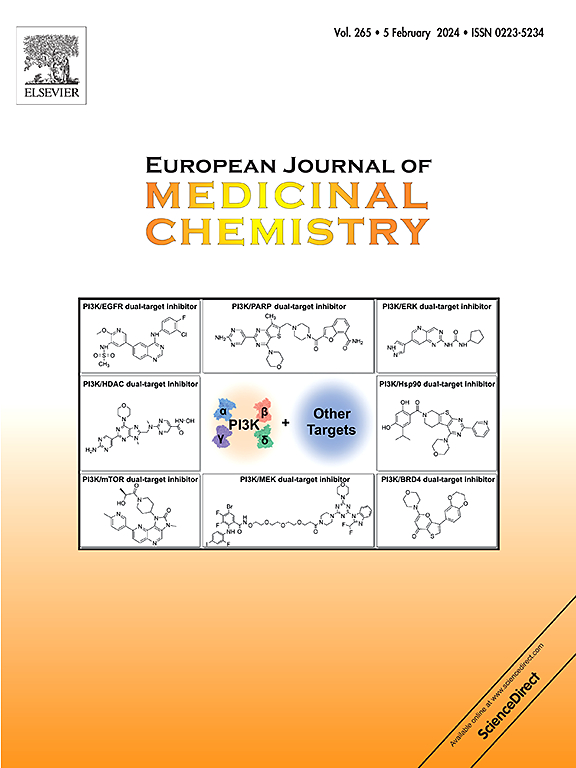Therapeutic targeting of ubiquitin-specific protease 7 (USP7): Mechanistic insights, dysregulation, and advances in drug discovery
IF 6
2区 医学
Q1 CHEMISTRY, MEDICINAL
引用次数: 0
Abstract
The ubiquitin-proteasome system (UPS) is a crucial regulator of many proteins, tagging them with ubiquitin as a post-translational modification (PTM) to be identified by proteasome for degradation. The ubiquitination process utilizes a cascade of enzymes involving ubiquitin-activating enzymes (E1), ubiquitin-conjugating enzymes (E2), and ubiquitin-ligases (E3), to covalently attach ubiquitin with pervasive assembly possibilities, known as the ubiquitin code. As part of physiological homeostasis, ubiquitin is reversibly cleaved from proteins via deubiquitylating enzymes (DUBs) in a well-orchestrated process, altering the protein's fate. Among the DUBs, ubiquitin-specific protease 7 (USP7) is considered a pivotal member due to its role in regulating the stability of multiple proteins involved in various biological activities, including p53 stability, DNA damage response, transcription, epigenetics, immune response, and viral infection. However, overexpression of USP7 is involved in many tumors and viral infections, rendering USP7 a promising target for therapeutic intervention. This review provides a brief discussion of the USP7 structure, its biological functions, and its role in disease pathology. The development of USP7 inhibitors is systematically summarized, ranging from irreversible covalent inhibitors, such as thiophene, thiazole, and tetrahydroacridine derivatives, to FT827 and XL177A, to reversible non-covalent inhibitors, including derivatives of indeno[1,2-b]pyrazine, 2-aminopyridine, pyrimidinone, imidazopyridine, 7-pyridyl-2,3-dihydrobenzofuran, and tetrahydroquinoline bi-aryl. Also, natural products, USP7 degraders, and computational efforts were covered. Reported activities and SAR are highlighted to assist drug discovery scientists in rationalizing the subsequent generation of USP7 inhibitors.


泛素特异性蛋白酶7 (USP7)的靶向治疗:机制、失调和药物发现进展
泛素-蛋白酶体系统(UPS)是许多蛋白质的重要调节因子,泛素作为翻译后修饰(PTM)标记它们,被蛋白酶体识别并降解。泛素化过程利用一系列酶,包括泛素激活酶(E1)、泛素偶联酶(E2)和泛素连接酶(E3),以共价方式将泛素与普遍的组装可能性结合起来,称为泛素代码。作为生理稳态的一部分,泛素通过去泛素化酶(DUBs)在一个精心安排的过程中从蛋白质中可逆地分离出来,改变了蛋白质的命运。在dub中,泛素特异性蛋白酶7 (USP7)被认为是一个关键成员,因为它可以调节参与各种生物活动的多种蛋白质的稳定性,包括p53稳定性、DNA损伤反应、转录、表观遗传学、免疫反应和病毒感染。然而,USP7的过表达参与了许多肿瘤和病毒感染,使USP7成为治疗干预的一个有希望的靶点。本文就USP7的结构、生物学功能及其在疾病病理中的作用作一综述。系统总结了USP7抑制剂的发展,从不可逆的共价抑制剂,如噻吩、噻唑和四氢吖啶衍生物,到FT827和XL177A,到可逆的非共价抑制剂,包括茚[1,2-b]吡嗪、2-氨基吡啶、嘧啶酮、咪唑吡啶、7-吡啶-2,3-二氢苯并呋喃和四氢喹啉双芳基衍生物。此外,还涵盖了天然产物、USP7降解物和计算工作。报告的活性和SAR被突出显示,以帮助药物发现科学家合理化下一代USP7抑制剂。
本文章由计算机程序翻译,如有差异,请以英文原文为准。
求助全文
约1分钟内获得全文
求助全文
来源期刊
CiteScore
11.70
自引率
9.00%
发文量
863
审稿时长
29 days
期刊介绍:
The European Journal of Medicinal Chemistry is a global journal that publishes studies on all aspects of medicinal chemistry. It provides a medium for publication of original papers and also welcomes critical review papers.
A typical paper would report on the organic synthesis, characterization and pharmacological evaluation of compounds. Other topics of interest are drug design, QSAR, molecular modeling, drug-receptor interactions, molecular aspects of drug metabolism, prodrug synthesis and drug targeting. The journal expects manuscripts to present the rational for a study, provide insight into the design of compounds or understanding of mechanism, or clarify the targets.

 求助内容:
求助内容: 应助结果提醒方式:
应助结果提醒方式:


